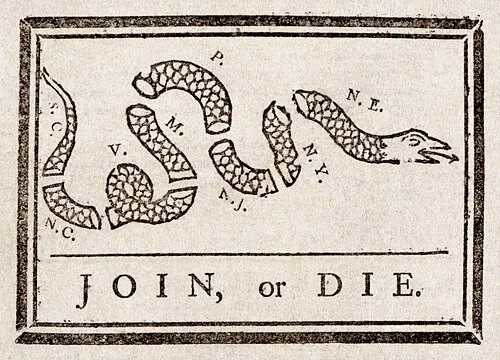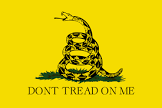Giving? Thanks!
I’ve been watching the 12-hour documentary on The American Revolution this week, and I’ve been struck by some of the similarities the “Americans” of the 1760’s and 1770’s have to us today.
Back then, we were an independent bunch -- God forbid anyone (except maybe God) told us what we could and couldn’t do – and we seemed to have much deeper allegiances to our tribes and communities and states than we did to our collective union or our overlords. That was fine with the British; it’s easier to defeat a colony than a country.
In order for the rebels/patriots to overcome the huge challenge of divorcing from Great Britain, they needed to move from thinking primarily about “me the person” and instead think of “we the people” — from the United States “are” to the United States “is.”
Southern states, with no previous interest in or respect for Northern states, realized that when Massachusetts citizens were attacked, it was better for all the colonies if they worked together. Ben Franklin’s “join or die” cartoon from the 1750’s, showing the fate of a snake of colonies chopped into parts, had never previously gained popular support from the colonists. But by the start of the revolution, the Gadsden Flag, showing a powerful coiled snake and the words “Don’t Tread on Me,” became a rallying cry for unity. Spoiler alert: the unity thing worked; the states, united, won.
Ben Franklin’s 1754 cartoon showing the impact of colonial disunity never caught on until the revolution came two decades later.
…when it morphed into the “Gadsden flag.”
These days we are once again fractured into factions, with our political parties delighted to keep us that way. We are a “me” generation of self-interested ingrates. We ask not what we can do for our country, but what our country can do for us.
It’s time for the reignition of an old idea: national service.
*******
I remember my first “great” public policy idea. I was substitute teaching a bunch of 7th graders in Portland Maine, trying to get them excited about Mark Twain’s book Pudd’nhead Wilson. Every couple of minutes the hormones of some helpless 13-year-old or another would erupt and they’d careen off the walls; the last thing they wanted was to be sitting still in a classroom. Then it hit me: this is when we should send them off for mandatory military service. In the military, they’d get some structure, and a couple of years to do what they obviously wanted to do -- break things and hurt people. Then, when they got back from service, they might be ready to learn.
My memory of a typical 7th grade classroom. (Image generated by deepai.org)
Shockingly, the idea of inducting 7th graders into the military never really gained momentum – parents were (generally) opposed and there was something about child labor laws – but I found myself coming back to a version of the idea this week while I was watching the American Revolution doc.
A powerful, well-supported, voluntary national service program for Americans between the ages of 18-24, would address a host of challenges our country is facing.
· Boys are struggling. They grow up slower than girls and show less interest in education. Richard Reeves has proposed “red-shirting” boys (a term borrowed from college sports – essentially giving them an additional year or two to catch up developmentally before being thrust into fully-competitive environments) in the period after high school and before going to college or into the workplace. National service could be where they spend their “red-shirt” time.
· Youth unemployment is soaring – outside of a blip for the pandemic, it’s the highest it’s been since 2016 – as companies cut back on new hires and show less commitment to taking on employees without experience in the real world. National service would give young people productive, important work experience. Colleges would get students more ready to learn with a purpose; companies would get de-risked, work-ready employees with new skills and energy.
· For young people who’ve grown up in monochromatic enclaves, national service would provide an excellent opportunity to learn how to work with the kinds of diverse colleagues they will join in their future jobs. In a recent column on national service, Scott Galloway quotes Congressman Jason Crow (D- Colorado), an Army veteran, who said this on the Raging Moderates podcast:
“When city kids get together with farm kids, and white, Black, Asian, Latino, straight and gay people roll up their sleeves and build something together…that creates a foxhole mentality that breaks down barriers and connects us.”
He’s not alone in seeing the value of that kind of exposure to each other. Republicans have co-sponsored legislation to expand national service and, as a candidate in 2016, Donald Trump said there was “something beautiful” about it (I don’t know what that means, but it’s not negative).
Singapore calls its national service program “school for the nation” because their studies find it does more than give young people a chance to grow up, gain important work skills and learn to work across lines of divide – it helps give them a sense of national identity.
We need to find a way to rediscover common purpose as a United States.
In the Depression, service through the Civilian Conservation Corps provided much-needed work for a jobless generation. For my grandfather’s and father’s generation, world wars brought the country together and equipped a generation with a can-do spirit. Since the 1960’s, the Peace Corps inspired a small number of young Americans to think beyond the country’s borders outside of wartime. And since the 1990’s, Americorps has given a small number of Americans a place to serve – by teaching in underserved schools, serving in nonprofits, working in national parks and other jobs.
Some positive things happen after young people do a stint of national service, according to a report from NIH: “higher levels of civic responsibility, voting, volunteering, employment, respect for diversity, and overall life skills such as decision-making and time management are all associated with AmeriCorps participation.”
An easy way to reignite a shared spirit and arm a generation with those skills would be to simply expand the AmeriCorps program. Right now Americorps only reaches about 75,000 out of each year’s 3.9 million high school graduates. More would like to do it; Congress has authorized up to 250,000 but hasn’t appropriated enough money to support it. The Brookings Institute has proposed expanding that number still further, to 600,000 young people a year. That would bring the total cost of the program to about $19 billion, or 0.16% of the federal budget.
Imagine how much 600,000 young people a year could do for our country — how much they could learn; how much they could serve (Image from La Puente).
I know: a billion here, a billion there – pretty soon it adds up to real money. A group called Voices for National Service has attempted to do a calculation of the return on investment the nation gets from the service of Americorps members. If you include the actual cost savings from the work done, the skills gained by workers that then translate into increased productivity in other jobs, tax revenue gains and projected reductions in costs of criminal justice and public health, their study estimates a 17:1 ROI of benefits to expenditures.
I’m always a little suspicious of studies like that – it’s hard to quantify direct and indirect benefits. But let’s say we “only” get a 2:1 ROI on the investment. It seems like a reasonable price to pay to get our next generation ready for work, school and service. It’s also a great way to remind ourselves of what “we the people” means… and to prepare a new generation for a lifetime of saying “thanks” through giving.
The American Revolution documentary closed by quoting from a speech Dr. Benjamin Rush gave in 1787, as he and other founders were heading off to write the Constitution. His main point: a republic is never finished — preserving it requires the ongoing commitment of all of us to perfect it: “Every man in a republic is public property. His time and talents—his youth—his manhood—his old age—nay more, life, all, belong to his country…come forward!”
-Leslie
Notes:
Benjamin Franklin’s “join or die” cartoon: https://en.wikipedia.org/wiki/Join,_or_Die
The Gadsden flag with “don’t tread on me”: https://www.google.com/search?q=don%27t.tread+on.me.origin&ie=UTF-8&oe=UTF-8&hl=en-us&client=safari
Richard Reeves’ excellent book Of Boys and Men includes his concept of “red-shirting”: https://www.amazon.com/Boys-Men-Modern-Struggling-Matters/dp/0815739877
Youth unemployment rate from BLS: https://www.bls.gov/news.release/pdf/youth.pdf
A really nice column from Scott Galloway on national service: https://www.profgalloway.com/national-service/
Rep. Jason Crow (D- Colorado) on national service: https://www.youtube.com/watch?v=76nDtAhShc8
How World War II service changed my father: https://www.boneconnector.com/writings/spirit-lessons-from-war
NIH study of impact of AmeriCorps on participants: https://www.ncbi.nlm.nih.gov/books/NBK284780/
Brookings on expanding Americorps: https://www.brookings.edu/articles/national-service-can-connect-americas-young-people-to-opportunity-and-community-and-promote-work-of-real-social-value/?utm_source=chatgpt.com
Voices for National Service ROI study: https://voicesforservice.org/news/press-release/new-research-shows-an-unprecedented-return-on-investment-to-the-federal-government-and-communities-from-americorps-and-senior-corps/#:~:text=Now%20we%20know%20that%20the%20return%20on,and%20return%20on%20investment%20study%20for%20the
Dr. Benjamin Rush’s “Address to the People of the United States,” January 1787: https://archive.csac.history.wisc.edu/Benjamin_Rush.pdf



